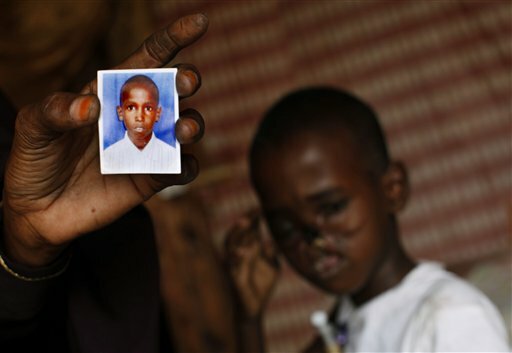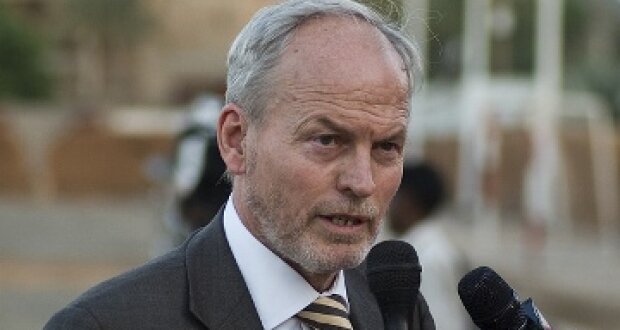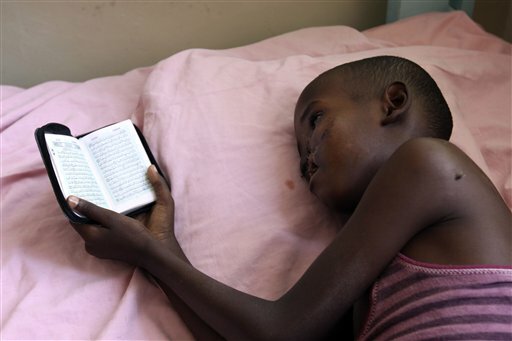 NAIROBI, Kenya — The bullet hit mother and son as they walked through Somalia’s capital. She felt a sharp pain in her palm. Then she saw her 8-year-old: The bullet tore through his cheekbones, nose and mouth. Blood gushed down to his waist.
NAIROBI, Kenya — The bullet hit mother and son as they walked through Somalia’s capital. She felt a sharp pain in her palm. Then she saw her 8-year-old: The bullet tore through his cheekbones, nose and mouth. Blood gushed down to his waist.
Two months later, Ahmed Mohamed Mohamoud’s nose is a small hole. His mouth is always open because he has no upper lip and his right eye is gone. He can barely speak.
His is a lost face of Somalia’s war.
Like so many other victims of a savage war, Ahmed was caught in the crossfire between Islamist insurgents and government forces, struck as he walked home from a Mogadishu market with his mother, who says a barrage of bullets poured out from the presidential palace.
Unlike Afghanistan and Iraq, there are few images of the bloodshed in Somalia, where thousands of children have been casualties without the world knowing. Most foreign journalists stay away because of the danger.
On Sept. 24, an Associated Press photographer was present after Ahmed was shot and took pictures of the boy, bleeding profusely as he was carried from the scene by two bystanders. During the weeks that followed, AP journalists kept tabs on Ahmed and his mother, who are still struggling with his grievous wounds.
“My heart bleeds whenever I recall his former face, whenever I compare the two faces,” said Safi Mohamed Shidane as she inspected her son’s scars at a hospital in neighboring Kenya, where Ahmed was flown for treatment after a Minnesota-based Somali immigrant group intervened.
“God will judge those who did this to my son,” she said.
The lack of basic medical care, much less specialized doctors, has worsened the plight of children wounded in Somalia, a country mired in chaos since the last central government was ousted in 1991 and warlords turned their guns on each other.
“Ahmed’s situation represents the crisis faced by many, many children in Somalia,” said Katherine Grant, a child protection specialist with UNICEF who has visited the boy in the hospital outside Nairobi. Her agency will soon release a report accusing all parties in Somalia’s conflict of recruiting child soldiers.
There are no reliable casualty figures for children in Somalia, according to Grant and Susannah Friedman, emergencies director for Somalia for Save the Children U.K.
“It is one of the most dangerous situations we’ve seen for children,” said Friedman, whose agency has aid workers in southern and central Somalia, but has pulled out of Mogadishu.
Yet even in violence-plagued Somalia, where the U.N. says one child in 10 dies before his or her first birthday and only 30 percent of the population has access to clean drinking water, Ahmed’s suffering tugged at heartstrings.
Doctors at Mogadishu’s Medina Hospital did all they could: They inserted a tracheotomy tube for Ahmed to breath and a feeding tube for nourishment. Doctors stitched together the horrific wounds to his face and wrapped it in thick layers of gauze.
But medical supplies — and expertise — are scarce in Somalia. When heavy fighting hits the seaside capital, tents go up at Medina to accommodate all the casualties. Inside, bloody footprints track down long corridors echoing with screams.
Appeals went out for help for Ahmed, including on Somali Web sites.
In late October, a Somali immigrant aid group, Healing the Children of Minnesota, had the boy flown to Kenya, where there are specialists and more advanced equipment. The Nigerian physician treating him there, Dr. Igohwo Etu, said the boy will need surgeries costing hundreds of thousands of dollars to reconstruct his face.
The Rochester, Minn.-based aid group is now trying to arrange treatment for Ahmed overseas and has contacted hospitals in the U.S., Britain, Italy and Mexico, its associate director, Abia Ali, said Monday.
The group, which is funded mainly by contributions from Somali immigrants, has helped 56 Somali war victims, mostly children, obtain medical care, according to its executive director, Abdi Gaal. These included two children treated at the Mayo Clinic and one at Fairview University in Minneapolis, Ali said.
Despite his uncertain future, Ahmed is a cheerful little boy who likes to play with a toy helicopter and spends time reading the Quran while lying in his hospital bed, his left eye twinkling as he scans the pages.
At the urging of his mother, he uttered a few words during a recent AP interview: “hooyo” — or “mother” in Somali — and his name.
But at other times the boy’s spirits sink.
His mother consoled him and wiped away tears that streamed from the swollen spot where his right eye once was, even as another tear dropped from his good eye and rolled into the opening where his lips and nose once were.
“With the help of God, you will recover and go back to your school,” his mother murmured, stroking her son.
Doctors had planned to remove Ahmed’s feeding tube Monday, but delayed the procedure until Nov. 30. Shidane says she was told that American or Canadian doctors might operate on Ahmed after the new year, but isn’t sure about future plans for her son.
Tens of thousands of Somalis have fled the fighting in Mogadishu, where gun battles occur daily and the Islamist insurgents hold public amputations and executions within shooting distance of the headquarters of the embattled government.
“Right now it’s very hard to be optimistic that the situation will improve, let alone that the violence will end,” said Chris Albin-Lackey, a researcher for Human Rights Watch. “In Mogadishu the situation is one of a bloody military stalemate. Neither side can gain the upper hand and the civilians are caught in between them.”
Associated Press Writer Christopher T. Williams in Minneapolis contributed to this report.







